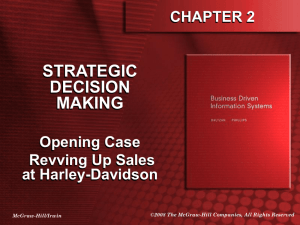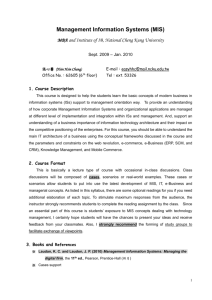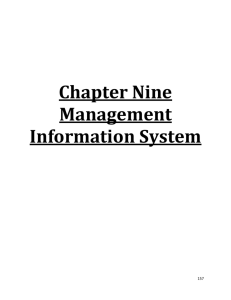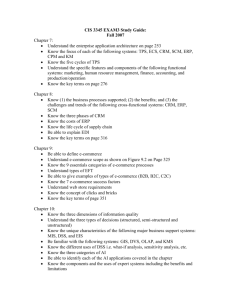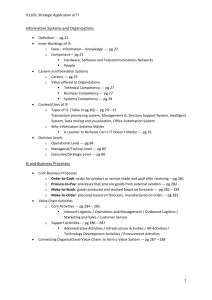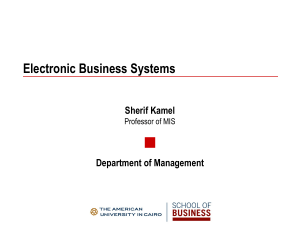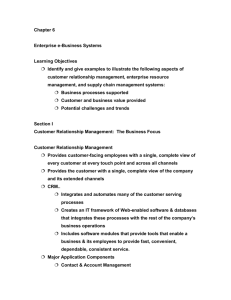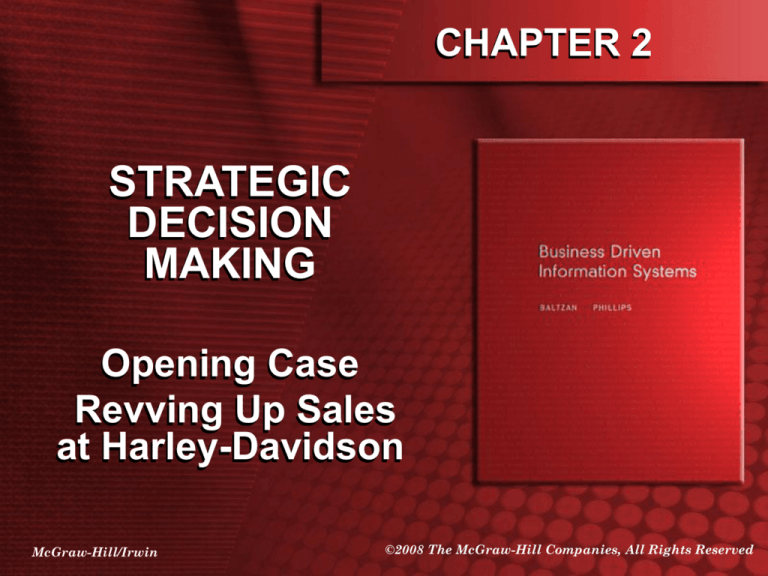
CHAPTER 2
STRATEGIC
DECISION
MAKING
Opening Case
Revving Up Sales
at Harley-Davidson
McGraw-Hill/Irwin
©2008 The McGraw-Hill Companies, All Rights Reserved
2-2
Richard Sears Decides to Sell
Products Through a Catalog
• Sears Roebuck changed the shape of an entire industry
by being lucky enough to discover a huge untapped
market that lay waiting to be discovered.
• In the 1880s about 65 percent of the population (58
million) lived in the rural areas. Richard Sears lived in
North Redwood, Minnesota, where he was an agent at
the Minneapolis and St. Louis railway station. Sears
began trading products such as lumber, coal, and
watches, when the trains would pass through.
• Sears moved to Chicago in 1893 and partnered with
Alvah C. Roebuck, and the Sears & Roebuck company
was born. The company first published a 32 page
catalog selling watches and jewelry. By 1895 the catalog
was 532 pages long and included everything from
fishing tackle to glassware. In 1893 sales reached
$400,000 and by 1895 sales topped $750,000.
2-3
Richard Sears Decides to Sell
Products Through a Catalog
• Sears invented many new marketing campaigns and
concepts that are still in use today, including a series of
rewards (or loyalty programs) for customers who passed
copies of the catalog on to friends and relatives.
• Sears was one of the first companies to recognize the
importance of building strong customer relationships.
Sears’ loyalty program gave each customer 24 copies of
the catalog to distribute, and the customer would
generate points each time an order was placed from
one of the catalogs by a new customer.
• The Sears catalog became a marketing classic. It
brought the world to the isolated farms and was a feast
for the new consumers. The entire world was available
through the Sears catalog, and it could be delivered to
the remotest of doorsteps.
2-4
What’s In A Name? A Lot!
•
•
•
•
•
•
Sunday, November 18, 1928, is a historic moment in time since it is the day that
the premier of Steamboat Willie debuted, a cinematic epic of seven minutes in
length. This was the first cartoon that synchronized sound and action.
Like all great inventions, Mickey Mouse began his life in a garage.
After going bankrupt with the failure of his Laugh O Gram Company, Walt Disney
decided to rent a camera, assemble an animation stand, and set up a studio in
his uncle’s garage. At the age of 21, Walt and his older brother Roy launched the
Disney Company in 1923.
Their first few films failed and it wasn’t until 1928 when they released a seven
minute film about a small mouse named Mickey. Disney never looked back.
The truth is Mickey Mouse began life as Mortimer Mouse. Walt Disney’s wife,
Lilly, did not like the name and suggested Mickey instead. Walt Disney has often
been heard to say “I hope we never lose sight of one fact – that this was all
started by a mouse.”
Would Mortimer have been as successful as Mickey? Would Mortimer have
been more successful than Mickey? How could Walt Disney have used
technology to help support his all-important decision to name his primary
character? There are many new technologies helping to drive decision support
systems, however it is important to note that some decisions, such as the name
of a mouse, are made by the most complex decision support system available,
the human brain.
2-5
The Harley-Davidson Mystique
• They have been ranked 1st in Fortune’s 5 Most Admired
Companies the motor vehicle industry, 2nd in
ComputerWorld’s Top 100 Best Places to Work in IT and 1st
in the Top 10 Sincerest Corporations in the Harris Interactive
Report
• HD’s technology budget is more than 2% of its revenue, far
above the industry average. More than 50% of the budget is
devoted to developing new technologies – information
sharing, business intelligence and enhancing decision
making. It has reduced operating costs by $40 million
through using strategic information systems
• Talon, it’s proprietary dealer management system handles
inventory, vehicle registration, warranties and POS
transactions for all dealerships. The system checks dealer
inventory, generates parts orders and analyzes global
organization information.
2-6
The Harley-Davidson Mystique
• HD uses software from Manugistics to enable the
company to so business with suppliers in a
collaborative, Web-based environment. It also has
SCM software to manage material flows and
improve collaboration with key suppliers.
• They CRM to build relationships and loyalty with
their customers and the Harley’s Owners Group
(HOG – over 600,000 members) offers events and
benefits to its members.
• The corporate culture led to its winning the awards
for best place to work and most admired company.
2-7
Overview
• Decision-enabling, problem-solving, and
opportunity-seizing systems
2-8
DECISION MAKING
• Reasons for the growth of decision-making
information systems
– People need to analyze large amounts of
information
– People must make decisions quickly
– People must apply sophisticated analysis
techniques, such as modeling and forecasting, to
make good decisions
– People must protect the corporate asset of
organizational information
2-9
DECISION MAKING
• Model – a simplified representation or
abstraction of reality
• IT systems in
an enterprise
2-10
TRANSACTION PROCESSING
SYSTEMS
• Moving up through the organizational pyramid users move
from requiring transactional information to analytical
information
2-11
TRANSACTION PROCESSING
SYSTEMS
• Transaction processing system (TPS) - the basic
business system that serves the operational level
(analysts) in an organization
–
–
–
–
–
Payroll system
Accounts Payable system
Accounts Receivable system
Course registration system
Human resources systems
• Online transaction processing (OLTP) – the capturing of
transaction and event information using technology to (1)
process the information according to defined business
rules, (2) store the information, (3) update existing
information to reflect the new information
• Online analytical processing (OLAP) – the manipulation
of information to create business intelligence in support of
strategic decision making
2-12
DECISION SUPPORT SYSTEMS
• Decision support system (DSS) – models
information to support managers and business
professionals during the decision-making process
–
–
One national insurance company using a DSS discovered
that only 3% of married male homeowners in their forties
received more than one DUI. The company lowered rates
for customers in this category, which increased its revenue
while mitigating its risk.
Burlington Northern and Santa Fe Railroad (BNSF)
regularly tests its railroad tracks. Each year hundreds of
train derailments result from defective tracks. Using a DSS
to schedule train track replacements helped BNSF
decrease its rail-caused derailments by 33%
2-13
DECISION SUPPORT SYSTEMS
• Three quantitative models used by DSSs include:
1. Sensitivity analysis – the study of the impact that
changes in one (or more) parts of the model have on
other parts of the model
2. What-if analysis – checks the impact of a change in
an assumption on the proposed solution
3. Goal-seeking analysis – finds the inputs necessary
to achieve a goal such as a desired level of output
2-14
DECISION SUPPORT SYSTEMS
• What-if analysis
Excel’s Scenario Manager
being used to determine
what will happen to total
sales as the price and
quantity of units sold
changes
2-15
DECISION SUPPORT SYSTEMS
• Goal-seeking analysis
Excel’s Goal Seek tool
being used to determine
how much money a
person can borrow with
an interest rate of 5.5%
and a monthly payment of
$1,300
2-16
Goal Seek Example
A salesperson participates in a bonus program that pays 3%
of all sales dollars.The salesperson wants to receive a
bonus of $2,500. What is the target amount of sales dollars
needed to reach that goal?
Put the correct formula in C5 for the computation of Bonus
Amount
Fix Bonus Amount to $2,500 and vary Sales Dollars until that
bonus amount is reached
Sales Dollars
Bonus Percentage
Bonus Amount
Click on Tools->Goal Seek
Set Cell ->C5 To Value 2500 By Changing Cell->C3
$1,000.00
3%
$30.00
2-17
DECISION SUPPORT SYSTEMS
• Interaction between a TPS and a DSS
2-18
EXECUTIVE INFORMATION
SYSTEMS
•
Executive information system (EIS) – a
specialized DSS that supports senior level
executives within the organization
•
Most EISs offering the following capabilities:
– Consolidation – involves the aggregation of
information and features simple roll-ups to complex
groupings of interrelated information
– Drill-down – enables users to get details, and
details of details, of information
– Slice-and-dice – looks at information from different
perspectives
2-19
EXECUTIVE INFORMATION
SYSTEMS
• Interaction between a TPS and an EIS
2-20
Digital Dashboards
•
•
Integrates information from multiple components and
presents it in a unified display
Executives can perform their own analysis, without
inundating IT personnel with queries and request for
reports, and quickly get results to respond to opportunities
2-21
Digital Dashboards
•
•
•
DDs commonly use indicators to help executives quickly
identify the status of key information or critical success
factors
DDs help executives react to information as it becomes
available and make decisions, solve problems and change
strategies daily instead of monthly
Verizon Communications CIO Shaygan Kheradpir tracks
100 plus major IT systems on a single screen called “The
Wall of Shaygan”
–
–
Every 15 seconds a new set of charts communicating Verizon’s
performance flashes onto a giant LCD screen in his officeand
include 300 measures of business performance that fall into 3
categories – Market Pulse, Customer Service and Cost Driver
400 managers at every level of Verizon have the same dashboard
2-22
Artificial Intelligence
• Intelligent system – various commercial
applications of artificial intelligence
• Artificial intelligence (AI) – simulates
human intelligence such as the ability to
reason and learn
– AI systems can learn or understand from
experience, make sense of ambiguous or
contradictory information and even use
reasoning to solve problems and make
decisions effectively
2-23
Artificial Intelligence
•
•
The AI Robot Cleaner at Manchester Airport in
England alerts passengers to security and
nonsmoking rules while it scrubs up to 65,600
square feet of floor per day
SmartPump keeps drivers in their cars on cold,
wet days
– The SmartPump can service any automobile built
after 1987 that has been fitted with a special gas cap
and a windshield-mounted transponder that tells the
robot where to insert the pump
•
The Miami Police Bomb squad’s AI robot that is
used to locate and deactivate bombs
2-24
Artificial Intelligence
• The ultimate goal of AI is the ability to build a
system that can mimic human intelligence
2-25
Artificial Intelligence
•
•
•
RivalWatch (ql2.com) offers a strategic
business information service using AI that
enables organizations to track the product
offerings, pricing policies, and promotions of
online competitors
Clients can determine the competitors they
want to watch and the specific information they
wish to gather, ranging from products added,
removed, or out of stock to price changes,
coupons offered, and special shipping terms
RivalWatch allows its clients to check each
competitor, category, and product either daily,
weekly, monthly, or quarterly
2-26
Artificial Intelligence
•
Four most common categories of AI include:
1. Expert system – computerized advisory programs that
imitate the reasoning processes of experts in solving
difficult problems
•
•
•
Human expertise is transferred to the expert system, and users
can access the expert system for specific advice
Most expert systems contain information from many human
experts and can therefore perform a better analysis than any
single human
MYCIN - outperformed members of the Stanford medical school
but not used because of ethical and legal issues related to the
use of computers in medicine
http://www.macs.hw.ac.uk/~alison/ai3notes/section2_5_5.htm
2-27
Artificial Intelligence
•
Four most common categories of AI include:
1. Expert system – computerized advisory programs that
imitate the reasoning processes of experts in solving
difficult problems
•
•
•
Human expertise is transferred to the expert system, and users
can access the expert system for specific advice
Most expert systems contain information from many human
experts and can therefore perform a better analysis than any
single human
MYCIN - outperformed members of the Stanford medical school
but not used because of ethical and legal issues related to the
use of computers in medicine
http://www.macs.hw.ac.uk/~alison/ai3notes/section2_5_5.htm
2-28
Artificial Intelligence
•
Countrywide Funding Corp uses an expert system
to improve decisions about granting loans using a
PC based system that makes preliminary
creditworthiness decisions on loan requests
– The systems has about 400 rules. It tested the system
against an actual underwriter and refined the system until
it agreed with the underwriter 95% of the time
– All rejected loans are reviewed by an underwriter
– An underwriter can now evaluate at least 16 loans per
day as compared to 6 or 7 previously
– The system is being used on their Web site to help
customers who are inquiring is they qualify for a loan
2-29
Artificial Intelligence
•
Galeria Kaufhof, a German superstore chain, uses
a rule-based system to help inspect the quality of
the 12,000 daily deliveries they receive of a wide
range of goods
– The system identifies high-risk deliveries (suppliers with
poor delivery history, new products) for inspection and
passes along the lower risk ones automatically
•
Successful expert systems deal with problems of
classification in which there are relatively few
alternative outcomes and in which the possible
outcomes are all known in advance
2-30
Traffic Light Expert System
2-31
Traffic Light Expert System
Is the light green (Yes/No)? No
Is the light red (Yes/No)? No
Is the light likely to change to red before you get
through the intersection (Yes/No)? Why?
Will only reach this point if light is yellow and
then you’ll have two choices.
Is the light likely to change to red before you get
through the intersection (Yes/No)? No
Conclusion: Go through the intersection
2-32
Loan Application Expert System
2-33
Artificial Intelligence
2. Neural Network – attempts to emulate the
way the human brain works
•
Neural networks are most useful for decisions that
involve patterns or image recognition
– Used for solving complex, poorly understood problems for
which large amounts of data have been collected
– Typically used in the finance industry to discover credit
card fraud by analyzing individual spending behavior
– US Bancorp has cut credit card fraud by 70% using this
technology
2-34
Artificial Intelligence
•
Fuzzy logic – a mathematical method of handling
imprecise or subjective information
– Values for ambiguous information range between 0 and 1.
A washing machine continues to wash until the clothes
are clean. How do you define clean? Analyze financial
information that has a subjective value (goodwill).
– In Japan, the subway system uses fuzzy logic controls to
accelerate so smoothly that standing passengers need
not hold on
– A system has been developed to detect possible fraud in
medical claims submitted by healthcare providers
2-35
Artificial Intelligence
•
Fuzzy logic can be used in a computer program to
automatically control room temperature
•
•
Cool is between 50-70 degress, although 60-67 is most
clearly cool. Cool is overlapped by cold and norm.
Thus a rule might be “if the temperature is cool or cold
and the humidity is low while the outdoor wind is high and
the outdoor temperature is low, raise the heat and
humidity in the room”
2-36
Neural Networks
–
–
–
A neural network is composed of several different
elements. Neurons are the most basic unit and are
interconnected. Each connection has a connection
weight which may differ from other connections.
A neuron is a communication conduit that accepts
input and produces output. The neuron receives its
input either from other neurons or the user program.
Similarly, the neuron sends its output to other neurons
or the user program.
When a neuron produces output, that neuron is said
to activate, or fire. A neuron will activate when the
sum of its inputs satisfies the neuron’s activation
function. The user decides what the trigger level will
be.
2-37
Neural Networks
• Neural nets consist of an input layer, output layer
and one or mode hidden internal layers
– Input and output layers are connected to the
middle layers by “weights” of various strengths
– Weights change as the net learns what is good
and bad (e.g. credit card transaction) and
stabilize after having been fed enough examples
– Differs from expert system in that expert system
follows rigid rules that don’t change. Neural net
rules change based on experience.
2-38
The Layers of a Neural Network
2-39
Neural Networks Can…
• Learn and adjust to new circumstances on
their own
• Take part in massive parallel processing
• Function without complete information
• Cope with huge volumes of information
• Analyze nonlinear relationships
2-40
Genetic Algorithms
3. Genetic algorithm – an artificial intelligent system that
mimics the evolutionary, survival-of-the-fittest process to
generate increasingly better solutions to a problem
•
•
Essentially an optimizing system, it finds the combination of inputs
that give the best outputs
Take thousands or even millions of possible solutions, combine and
recombine them until the optimal solution is found
–
Example: Create a portfolio of 20 stocks with growth rate of 7.5%
• Pick a large group of stocks, combine them into groups of 20 at a
time and see how each group performed based on historic
information
• 30 stocks 30 million combinations, 40 stocks 137 billion
possibilities of 20
• US West uses this technique to determine the optimal configuration
of fiber-optic cable in a network that may include as many as
100,000 connection points
–
Used take 2 months for an experienced designer, now 2 days and saves $1-$10
million each time it’s used
2-41
Evolutionary Principles of Genetic Algorithms
1. Selection – or survival of the fittest or
giving preference to better outcomes
2. Crossover – combining portion of good
outcomes to create even better
outcomes
3. Mutation – randomly trying
combinations and evaluating the
success of each
2-42
The basic genetic algorithm
• Start with a large “population” of randomly generated
“attempted solutions” to a problem
• Repeatedly do the following:
– Evaluate each of the attempted solutions
– Keep a subset of these solutions (the “best” ones)
– Use these solutions to generate a new population
• Quit when you have a satisfactory solution (or you run
out of time)
2-43
A really simple example
• Suppose your “organisms” are 32-bit computer words
• You want a string in which all the bits are ones
• Here’s how you can do it:
– Create 100 randomly generated computer words
– Repeatedly do the following:
• Count the 1 bits in each word
• Exit if any of the words have all 32 bits set to 1
• Keep the ten words that have the most 1s (discard the rest)
• From each word, generate 9 new words as follows:
– Pick a random bit in the word and toggle (change) it
• Note that this procedure does not guarantee that the next
“generation” will have more 1 bits, but it’s likely
2-44
Asexual vs. sexual reproduction
• In the examples so far,
– Each “organism” (or “solution”) had only one parent
– Reproduction was asexual (without sex)
– The only way to introduce variation was through
mutation (random changes)
• In sexual reproduction,
– Each “organism” (or “solution”) has two parents
– Assuming that each organism has just one
chromosome, new offspring are produced by forming
a new chromosome from parts of the chromosomes
of each parent
2-45
The really simple example again
• Suppose your “organisms” are 32-bit computer
words, and you want a string in which all the bits
are ones
• Here’s how you can do it:
– Create 100 randomly generated computer words
– Repeatedly do the following:
• Count the 1 bits in each word
• Exit if any of the words have all 32 bits set to 1
• Keep the ten words that have the most 1s (discard the rest)
• From each word, generate 9 new words as follows:
– Choose one of the other words
– Take the first half of this word and combine it with the
second half of the other word
2-46
The example continued
• Half from one, half from the other:
0110 1001 0100 1110 1010 1101 1011 0101
1101 0100 0101 1010 1011 0100 1010 0101
0110 1001 0100 1110 1011 0100 1010 0101
• Or we might choose “genes” (bits) randomly:
0110 1001 0100 1110 1010 1101 1011 0101
1101 0100 0101 1010 1011 0100 1010 0101
0100 0101 0100 1010 1010 1100 1011 0101
• Or we might consider a “gene” to be a larger unit:
0110 1001 0100 1110 1010 1101 1011 0101
1101 0100 0101 1010 1011 0100 1010 0101
1101 1001 0101 1010 1010 1101 1010 0101
2-47
Comparison of simple examples
• In the simple example (trying to get all 1s):
– The sexual (two-parent, no mutation) approach, if it
succeeds, is likely to succeed much faster
• Because up to half of the bits change each time, not just one
bit
– However, with no mutation, it may not succeed at all
• By pure bad luck, maybe none of the first (randomly
generated) words have (say) bit 17 set to 1
– Then there is no way a 1 could ever occur in this position
• Another problem is lack of genetic diversity
– Maybe some of the first generation did have bit 17 set to 1, but
none of them were selected for the second generation
• The best technique in general turns out to be sexual
reproduction with a small probability of mutation
2-48
Genetic Algorithm Applications
• GE used them help optimize the design of
a jet turbine aircraft engine
• SCM software from i2 Technologies
optimizes production-scheduling models
incorporating hundreds of thousands of
details about customer orders, material
and resource availability, manufacturing
and distribution capability and delivery
dates
2-49
Intelligent Agents
4. Intelligent agent – special-purposed
knowledge-based information system that
accomplishes specific tasks on behalf of its
users
•
•
•
–
–
–
–
Used for environmental scanning and competitive intelligence
An intelligent agent can learn the types of competitor
information users want to track, continuously scan the Web
for it, and alert users when a significant event occurs
software that assists you, or acts on your behalf, in
performing repetitive computer-related tasks (e.g., paper clip
in Word)
Buyer agents or shopping bots
User or personal agents
Monitoring-and surveillance agents
Data-mining agents
2-50
Deep Space 1
Launched:
Oct 24, 1998
Terminated:
Dec. 18, 2001
Out of this World
Agents
Successfully tested
12 high-risk,
advanced space
technologies
2-51
Deep Space 1
• NASA is looking to change its exploration paradigm
– Build spacecraft quickly, make them small enough to be launched on
inexpensive rockets and fast enough to reach their destinations while the
questions they are addressing are still relevant.
– Launch them monthly so that if one or two of them fail the loss will
represent a small portion of the project
• The spacecraft must also be sufficiently sophisticated to collect the
desired information and smart enough to handle unexpected
situations without all of them tying up the precious and expensive
Deep Space Network.
• NASA's New Millennium program is chartered to validate selected
high-risk technologies needed to accomplish this goal on DS1, the
first of the program's space flights. Amoung these technologies is:
– AUTONOMOUS OPERATIONS SYSTEM - An "agent" plans, make
decisions, and operate by itself. Sophisticated software is programmed into
the spacecraft's computer to allow it to think and act on its own, without
human intervention or guidance. The agent also knows when a failure has
occurred, what to do about it, and when to call for help.
2-52
Agents Sense & Respond
An agent receives input from its environment
and, through a repertoire of actions available
to it, reacts to it in order to modify it.
sensory input
effector output
Environment
2-53
Buyer Agents
• Buyer agent or shopping bot – an
intelligent agent on a Web sites that helps
you, the customer, find products and
services you want
– When you log on to Amazon.com, you are
presented with suggestions of things to
purchase based on previous activity at the
website (uses collaborative filtering)
2-54
User Agents
• User agent or personal agent –
intelligent agent that takes action on your
behalf
• Examples:
– Prioritize e-mail and alert you when important
items arrive
– Act as gaming partner
– Assemble customized news reports (CNN)
– Fill out forms for you
– Negotiate deals with suppliers and
distributors
2-55
Monitoring-and-Surveillance Agents
• Monitoring-and-surveillance
(predictive) agents – intelligent agents
that observe and report on equipment.
– Deep Space 1
– Network monitoring – predict crash 45
minutes in advance (also uses neural
network to look for patterns of activity or
problems)
2-56
Data-Mining Agents
• Data-mining agent – operates in a data
warehouse discovering information
– Used in conjunction with neural networks to
classify data
– Detect a major shift in a trend or indicator or
the presence of new information
• Volkswagen tracks market conditions to predict
changes in consumer purchasing or payments
and proactively take steps to protect themsleves
2-57
Data Mining
• Data-mining systems sift instantly through
information to uncover patterns and
relationships
• Data-mining systems include many forms
of AI such as neural networks and expert
systems
2-58
ENTERPRISE SYSTEMS
• Organizations can undertake high-profile
strategic initiatives including:
– Supply chain management (SCM)
– Customer relationship management (CRM)
– Business process reengineering (BPR)
– Enterprise resource planning (ERP)
2-59
SUPPLY CHAIN MANAGEMENT
• Supply Chain Management (SCM) –
involves the management of information
flows between and among stages in a
supply chain to maximize total supply
chain effectiveness and profitability
2-60
SUPPLY CHAIN MANAGEMENT
•
Four basic components of supply chain
management include:
1. Supply chain strategy is the strategy for managing all
the resources required to meet customer demand for all
products and services.
2. Supply chain partners are the partners chosen to
deliver finished products, raw materials, and services
including pricing, delivery, and payment processes
along with partner relationship monitoring metrics.
3. Supply chain operation is the schedule for production
activities including testing, packaging, and preparation
for delivery.
4. Supply chain logistics is the product delivery
processes and elements including orders, warehouses,
carriers, defective product returns, and invoicing.
2-61
SUPPLY CHAIN MANAGEMENT
•
•
An organization generates tremendous operational
efficiencies when it automates these steps and the
information flows among them
Wal-Mart and P&G implemented a tremendously
successful SCM which linked Wal-Mart’s distribution
centers directly to P&G’s manufacturing centers
–
–
–
–
Each time a Wal-Mart customers purchases a P&G product,
the system sends a message directly to P&G’s factory for a
reorder
When a product is running low at one of Wal-Mart’s
distribution center the system sends an automatic alert to
P&G
This allows P&G to satisfy Wal-Mart’s needs without having
to maintain large inventories in its warehouses
The system saves time, reduces inventory and decreases
order-processing costs for P&G which are passed on to
Wal-Mart in the form of discounted prices
2-62
SUPPLY CHAIN MANAGEMENT
• Wal-Mart and Procter & Gamble (P&G) SCM
The supply chain is dynamic and the flow of
information between parties is continuous
2-63
SUPPLY CHAIN MANAGEMENT
• Effective and efficient SCM systems can
enable an organization to:
– Decrease the power of its buyers
– Increase its own supplier power
– Increase switching costs to reduce the threat of
substitute products or services
– Create entry barriers thereby reducing the threat
of new entrants
– Increase efficiencies while seeking a competitive
advantage through cost leadership
2-64
SUPPLY CHAIN MANAGEMENT
• Effective and efficient SCM systems effect
on Porter’s Five Forces
2-65
CUSTOMER RELATIONSHIP
MANAGEMENT
• Customer relationship management
(CRM) – involves managing all aspects of a
customer’s relationship with an organization
to increase customer loyalty and retention
and an organization's profitability
– CRM systems help organizations understand
and manage their customers
• Many organizations, such as Charles
Schwab and Kaiser Permanente, have
obtained great success through the
implementation of CRM systems
2-66
CUSTOMER RELATIONSHIP
MANAGEMENT
• Charles Schwab recouped the cost of a
multimillion-dollar CRM system in less than two
years
– The system allowed Schwab to segment its customers
in terms of serious and non-serious investors
• The CRM system looked for customers that had automatic
withdrawal from a bank account as a sign of a serious investor
• The CRM system looked for stagnant balances as a sign of a
non-serious investor
– Charles Schwab could then focus efforts on selling to
serious investors, and spend less time attempting to sell
to non-serious investors
• Kaiser used CRM to enforce more rigorous eyescreening for diabetic patients
2-67
CUSTOMER RELATIONSHIP
MANAGEMENT
• CRM is not just technology, but a strategy,
process, and business goal that an organization
must embrace on an enterprisewide level
– Although CRM has many technical components, it is
actually a process and business goal simply enhanced
by technology
– Organizations must first decide that they want to build
strong customer relationships and then they determine
how IT can support their goals
• CRM can enable an organization to:
–
–
–
–
Identify types of customers
Design individual customer marketing campaigns
Treat each customer as an individual
Understand customer buying behaviors
2-68
CUSTOMER RELATIONSHIP
MANAGEMENT
• Customers contact organizations multiple times through
numerous channels
• Each contact can be stored in a different system or
different database. For example, a sales call and a billing
call will be maintained in two different databases
• The CRM system tracks all of the different contacts
through the various channels and collates the information
into a central repository
• This gives the organization a complete and total view of
its customers, along with their purchases, questions,
issues, and concerns, in one single place
• Why is it so important for an organization to embrace
CRM on an enterprisewide level?
2-69
CUSTOMER RELATIONSHIP
MANAGEMENT
• CRM
overview
2-70
BUSINESS PROCESS REENGINEERING
• Business process – a standardized set of
activities that accomplish a specific task, such as
processing a customer’s order
• Business process reengineering (BPR) – the
analysis and redesign of workflow within and
between enterprises
– The purpose of BPR is to make all business processes
best-in-class
Any broken processes in the college? Other places?
How would you fix them?
2-71
BUSINESS PROCESS REENGINEERING
• BPR reached its heyday in the early 1990s when Michael
Hammer and James Champy published their best-selling
book, Reengineering the Corporation.
• The authors promoted the idea that radical redesign and
reorganization of an enterprise (wiping the slate clean)
sometimes was necessary to lower costs and increase
quality of service and that information technology was the
key enabler for that radical change.
• Hammer and Champy believed that the workflow design in
most large corporations was based on invalid assumptions
about technology, people, and organizational goals. They
suggested seven principles of reengineering to streamline
the work process and thereby achieve significant
improvement in quality, time management, and cost.
2-72
BUSINESS PROCESS REENGINEERING
2-73
Finding Opportunity Using BPR
• A company can improve the way
it travels the road by moving
from foot to horse and then
horse to car
• BPR looks at taking a different
path, such as an airplane which
ignore the road completely
– Companies often follow the
same indirect path for doing
business, not realizing there
might be a different, faster, and
more direct way of doing
business.
2-74
Finding Opportunity Using BPR
• Radical and fundamentally new business processes
enabled Progressive Insurance to slash the claims
settlement from 31 days to four hours.
– Typically, car insurance companies follow this standard claims
resolution process: The customer gets into an accident, has the car
towed, and finds a ride home. The customer then calls the insurance
company to begin the claims process, which usually takes over a
month.
• Progressive Insurance improved service to its customers by
offering a mobile claims process.
– When a customer has a car accident he or she calls in the claim on
the spot. The Progressive claims adjustor comes to the accident and
performs a mobile claims process, surveying the scene and taking
digital photographs. The adjustor then offers the customer on-site
payment, towing services, and a ride home.
2-75
Finding Opportunity Using BPR
• Progressive Insurance mobile claims process
2-76
Finding Opportunity Using BPR
• Types of change
an organization
can achieve,
along with the
magnitudes of
change and the
potential
business benefit
2-77
Finding Opportunity Using BPR
• A true BPR effort does more for a company than simply
improve it by performing a process better, faster, and
cheaper
• Progressive Insurance’s BPR effort redefined best practices
for its entire industry
• The Process Change Spectrum displays the different types
of change an organization can achieve, along with the
magnitude of change and the potential business benefit
– Automate – answering phones with computers, auto grading an
essay or Excel project
– Streamline – remove duplicate jobs in the process, use a different
tool to perform the same task
– BPR – taking an airplane instead of a bike, horse, or car
– Strategic reengineering – taking BPR to the level where you redefine
an entire industry – such as Progressive Insurance
2-78
ENTERPRISE RESOURCE PLANNING
• Enterprise resource planning (ERP) –
integrates all departments and functions
throughout an organization into a single IT
system so that employees can make
decisions by viewing enterprisewide
information on all business operations
– What would happen if the sales and
marketing departments are working from two
different sets of customer information and
product information
• Keyword in ERP is “enterprise”
2-79
ENTERPRISE RESOURCE PLANNING
• A few years ago, each of the government departments
of the city of Los Angeles conducted its own purchasing
– 2,000 people in 600 city buildings and 60
warehouses issued 120,000 purchase orders and
50,000 checks per year went to more than 7,000
vendors
– Inefficiency was rampant: unauthorized expenditures,
each dept maintained its own inventory on different
systems, mainframe systems were isolated
– An ERP system was implemented which resulted in:
• cutting the check processing staff in half, processing POs
faster than ever, reducing the number of workers in the
warehouses by 40, decreasing inventories from $50 million
to $15 million and providing a single point of contact for each
vendor.
• $5 million a year has been saved in contract consolidation
2-80
ERP SOFTWARE
• ERP functions offered by all ERP vendors include:
– Finance, accounting, sales, marketing, human resources,
operations, and logistics
– Many companies strive to make good financial decisions by
making smart investments. The best way to ensure a good
investment in ERP is to understand why failure occurs and how
to avoid it.
• ERP vendors differentiate themselves by offering unique
components including CRM, SCM, and BI
– ERP comes in many flavors. The business world has many
different business models with many ERP products available
that serve them. Companies must find the right fit before it
purchases an ERP system.
• According to Gartner, the average failure rate for an ERP
project is 66 percent but it is still considered a necessary,
strategic evil
2-81
Finding The Right ERP Solution
•
Successful ERP projects share 3 attributes
1.
Overall fit - the degree of gaps that exist between the system and
the business process. A well-fitting ERP has no major process
gaps and very few minor ones
•
2.
Proper business analysis
•
3.
Off the rack; Off the rack and tailored to fit; Custom made
Successful companies spend up to 10 percent of the project budget
on a business analysis in order to determine which “fit” strategy is right
for them
Solid implementation plans
•
•
A plan is needed to monitor the quality, objectives, and timelines
A thorough implementation will transfer knowledge to system users.
When the project is complete, employees must be capable of using
the tools the new system provides. The users must also know what to
do in cases when the process fluctuates. Most failed systems result
from poor quality implementation. ERP is simply a tool
2-82
CLOSING CASE ONE
Consolidating Touchpoints for Saab
•
Consolidated three customer databases that
were independent of each other and causing
problems for sales and marketing
–
–
–
•
Dealer network
Customer assistance center
Lead management center
Provided the following benefits
–
–
–
–
Direct marketing costs decreased by 5%
Lead follow-up increased from 38% to 50%
Customer satisfaction increased from 69% to 75%
Saab gained a single view of its customers across
multiple channels
2-83
CLOSING CASE TWO
Made-to-Order Businesses
• Land’s End, Nike and Stamps.com are
able to provide “mass customization”
because of IT technology
– SCM and CRM are the enablers of a mass
customization strategy. To allow customers to
define their own products the supply chain
must support individual production and the
CRM system must support customizable
orders. Without these two critical components
a mass customization strategy would be
extremely difficult to implement.
2-84
CLOSING CASE THREE
Delta Airlines Plays Catch-Up
1. What business risks would Delta be taking if it
decided not to catch up with industry leaders in
using IT to gain a competitive advantage?
2. What competitive advantages can an airline gain
by using DSS and EIS?
3. What other industries could potentially benefit
from the use of yield management systems?
2-85
IT and the Airline Industry
•
•
•
Sabre and Apollo
Frequent Flyer Programs
Yield Management Systems


